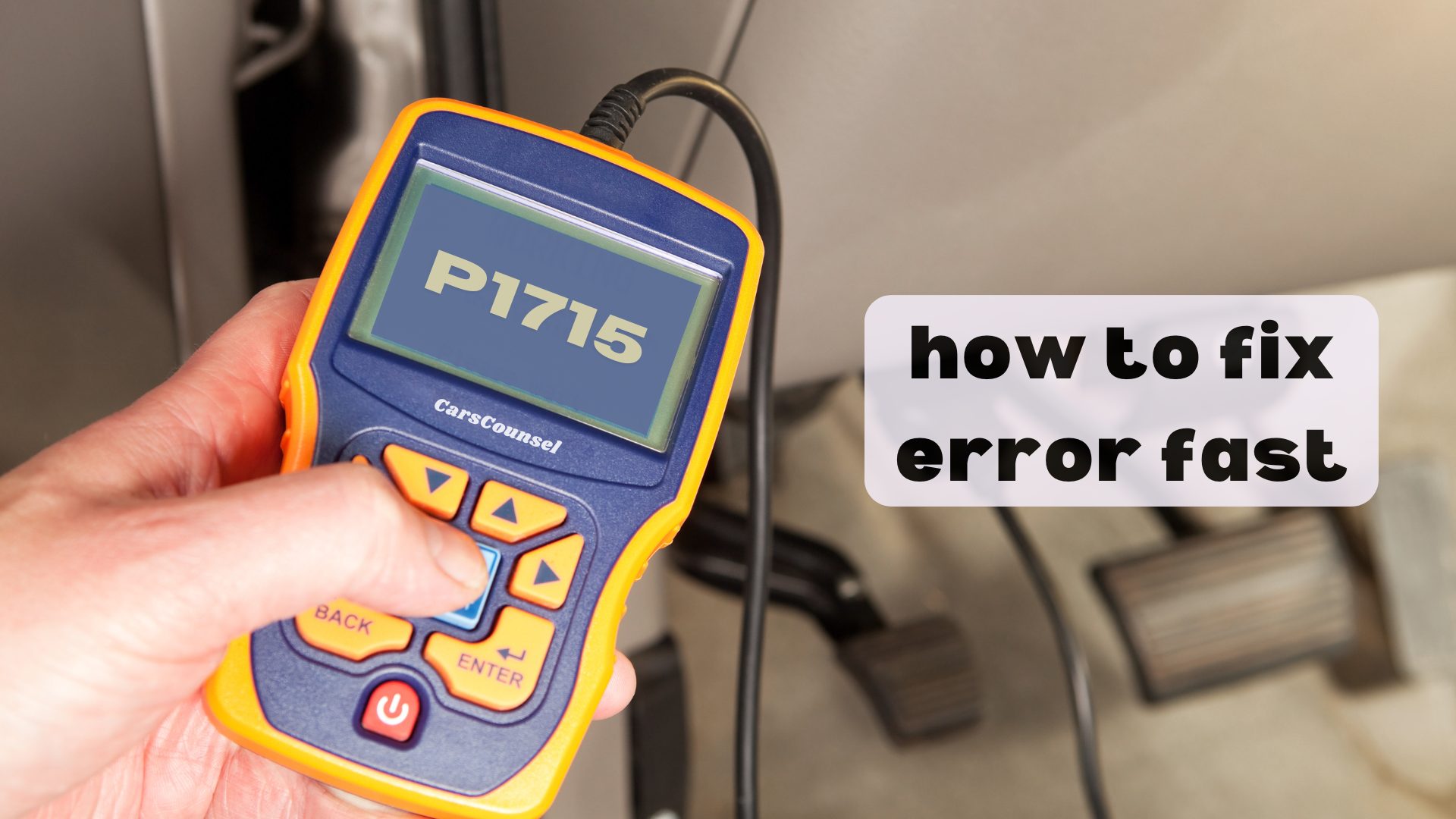You’re seeing the P1715 code and want to fix it quickly. Where do you start?
First, get an OBD-II scanner to confirm the error code and find any related codes.
Next, check the transmission range sensor and its wiring for any damage or loose connections.
This is just the beginning, though. To diagnose thoroughly, use a multimeter to test the sensor’s voltage and resistance, making sure everything matches the manufacturer’s specs.
But what should you do if you find faulty parts or issues with the transmission fluid?

Quick Navigation
Key Takeaways
- Use a car diagnostic tool to read and clear the P1715 error code.
- Check and secure all wiring connections related to the transmission range sensor.
- Replace the faulty transmission range sensor if it shows incorrect voltage readings.
- Change dirty transmission fluid according to the manufacturer’s guidelines.
What Is the P1715 Code?
The P1715 code shows a problem with the transmission range sensor circuit.
This sensor helps the vehicle’s computer know which gear you’re in. If the sensor gives strange voltage readings, it can mess up how your transmission shifts gears.
When this happens, your car mightn’t shift smoothly.
Fixing the sensor issue quickly can help keep your transmission working well.
Common Symptoms
If you’re noticing rough shifting and unexpected gear changes, your car might have a P1715 code issue. It’s important to spot these problems early to fix transmission issues.
You might experience uneven acceleration, a delay when changing gears, or strange shifting behaviors. These signs usually mean the transmission range sensor isn’t sending the right information to the Transmission Control Module (TCM), leading to unusual voltage readings.
You might also see the check engine light or a transmission warning light come on. Lower gas mileage and overheating are common too, showing that the transmission isn’t working properly.
Catching these symptoms early helps avoid more damage and ensures your car gets fixed quickly and correctly.
Main Causes
Finding the main causes of the P1715 code involves looking into issues like a bad transmission range sensor, a faulty Transmission Control Module (TCM), electrical problems, dirty transmission fluid, or mechanical issues in the transmission system.
Here are some things to check:
- Bad Transmission Range Sensor: If the sensor is worn out, you’ll need to replace it.
- Faulty TCM: Problems with the TCM might require reprogramming or getting a new one.
- Electrical Problems: Look for and fix any loose or corroded connections.
Affected Vehicles
After looking into the main causes of the P1715 code, it’s clear that certain car models like the Nissan Maxima (2004-2006), Ford Focus (2000-2011), and Mazda 3 (2004-2013) are more likely to have this problem because of weaknesses in their transmission parts.
These cars often have issues with their transmission sensors, which can cause strange voltage readings and lead to transmission problems. Common issues include broken transmission range sensors, faulty transmission control modules (TCMs), and damaged transmission pressure control solenoids.
These problems can cause symptoms like rough shifting and transmission overheating. It’s important to diagnose and fix these issues quickly to prevent more damage and keep the car running well.
Knowing these common problems helps in finding and fixing them efficiently.
Diagnostic Tools
To diagnose the P1715 code effectively, you’ll need several key tools like an OBD-II scanner, a multimeter for checking voltage and resistance, and possibly advanced equipment to analyze the transmission control module (TCM). Using these tools will make your troubleshooting more accurate.
Here’s what you’ll need:
- OBD-II Scanner: This is crucial for getting diagnostic trouble codes (DTCs) and real-time data.
- Multimeter: Important for measuring voltage and resistance in the transmission circuits.
- Advanced Diagnostic Tools: Useful for detailed TCM analysis.
Using these tools will make it easier to find and fix the P1715 code accurately.
Initial Code Reading
Start by using your OBD-II scanner to get the P1715 code and any other error codes from your car’s computer. It’s easy to use the scanner: just plug it into the OBD-II port, usually found under the dashboard.
Once connected, access the car’s ECU to pull out the codes. The P1715 code means there’s an issue with the transmission range sensor circuit.
Make a note of any other error codes too, as they can give you more clues about related problems. Understanding these codes helps you figure out possible causes like broken sensors or problems with the TCM, and plan your next steps for fixing the issue.
Getting the codes right at the start is key for effective troubleshooting and repair.
Visual Inspection Steps
When diagnosing the P1715 code, carefully check the wiring and connectors related to the transmission control module (TCM) for any signs of wear, rust, or damage. Use a visual inspection checklist to make your troubleshooting smoother.
- Inspect Wiring: Look for worn-out wires, loose connections, or visible damage.
- Check Connectors: Make sure connectors are secure, free of rust, and properly plugged in.
- Examine Sensor Connections: Verify that all sensor links to the TCM are intact and undamaged.
Following this visual inspection checklist will help you quickly find electrical issues, making it easier to fix the P1715 error code.
Transmission Fluid Check
Checking the transmission fluid means looking at the fluid level and condition to ensure your transmission works well and to avoid triggering the P1715 error code.
First, make sure your car is on a flat surface. Find the transmission dipstick, pull it out, and wipe it clean. Put it back in and then pull it out again to check the fluid level.
To check the fluid quality, look at the color and smell it; it should be a clear red and shouldn’t smell burnt.
Keeping up with transmission fluid maintenance is important. Change the fluid as recommended by the manufacturer and check for leaks.
Bad or dirty fluid can cause problems with the transmission range sensor, so following these steps can help you avoid issues related to the P1715 code.
Electrical Testing
To figure out what’s causing the P1715 code, you need to check the voltage and resistance in the transmission range sensor circuit. Start by looking at the wiring harness for any damage. Use a digital multimeter to test the circuit and make sure the voltage levels and connections are correct.
- Check Connectors: Make sure all connectors in the transmission range sensor circuit are secure and not corroded.
- Inspect Wiring: Look for any frayed or broken wires that might cause short circuits.
- Measure Resistance: Use the multimeter to measure resistance at the transmission range sensor terminals.
This careful method will help you accurately find any electrical problems.
Repair and Prevention
To fix and prevent the P1715 code, you need both quick fixes and regular maintenance.
First, try replacing the broken transmission range sensor, reprogramming or swapping out the transmission control module (TCM), and making sure all electrical connections are tight and free from rust. If the transmission fluid looks dirty, change it and replace the filter to keep the fluid pressure at its best.
To prevent future problems, follow these tips: change the transmission fluid regularly as the manufacturer recommends and check the electrical system often for any signs of wear or damage.
Keep an eye on how your vehicle is running and take care of any dashboard warning lights right away to stop problems from getting worse. These steps will help avoid the P1715 code from coming back and make your transmission last longer.
More OBD-II Codes
Frequently Asked Questions
How Urgent Is It to Fix the P1715 Code Once Detected?
How urgent is it to fix the P1715 code once detected?
You need to fix the P1715 code as soon as possible if you notice issues like your transmission overheating, rough shifting, or gears slipping. Taking care of it right away can prevent serious damage and help your transmission last longer.
Can Driving With the P1715 Code Damage My Transmission Further?
Driving with the P1715 code can make transmission problems worse and might cause serious damage. It’s important to use diagnostic tools right away to find the issues and stop your transmission from getting worse.
What Are the Potential Costs of Repairing a P1715 Code Issue?
You’ll usually pay between $200 and $600 to fix a P1715 code problem, plus an extra $100 for the diagnostic check. The total cost depends on whether you need to replace the Transmission Control Module (TCM), the transmission range sensor, or fix electrical issues.
Is It Possible to Prevent the P1715 Code Entirely With Regular Maintenance?
Yes, you can stop the P1715 code from happening with some preventive steps. Regularly check your transmission parts, keep the fluid levels right, and make sure all the electrical connections are good. Doing this routine maintenance helps reduce the chance of sensor or TCM issues.
Can Aftermarket Parts Be Used to Fix a P1715 Code, or Are OEM Parts Necessary?
You can use aftermarket parts to fix a P1715 code, but make sure they are compatible with your vehicle. OEM parts are often better because they fit perfectly and come from the original manufacturer, which means they are more reliable. It’s important to choose high-quality parts to keep your transmission in good shape and prevent future problems.
Conclusion
To quickly fix the P1715 code, start by confirming it with an OBD-II scanner.
Then, do a thorough visual inspection and make sure all connections are secure.
Test key parts like the transmission range sensor and TCM for proper voltage and resistance.
Replace any faulty parts.
Also, check that the transmission fluid is clean and at the right level.
Regular maintenance and careful checks can prevent problems and keep your vehicle running well.

